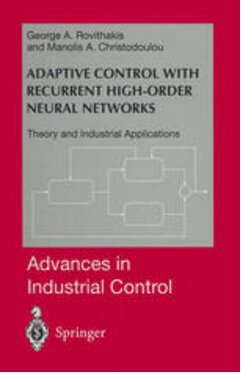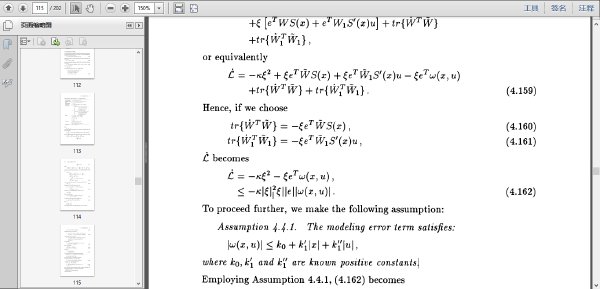電驢下載基地 >> 图书资源 >> 教育科技 >> 《高階遞歸自適應神經網絡:理論與工業應用》(Adaptive Control with Recurrent High-order Neural Networks: Theory and Industrial Applications)文字版[PDF]
| 《高階遞歸自適應神經網絡:理論與工業應用》(Adaptive Control with Recurrent High-order Neural Networks: Theory and Industrial Applications)文字版[PDF] | |
|---|---|
| 下載分級 | 图书资源 |
| 資源類別 | 教育科技 |
| 發布時間 | 2017/7/18 |
| 大 小 | - |
《高階遞歸自適應神經網絡:理論與工業應用》(Adaptive Control with Recurrent High-order Neural Networks: Theory and Industrial Applications)文字版[PDF] 簡介: 簡 介 中文名 : 高階遞歸自適應神經網絡:理論與工業應用 原名 : Adaptive Control with Recurrent High-order Neural Networks: Theory and Industrial Applications 別名 : 無 作者 : George A. Rovithakis Manolis A.
"《高階遞歸自適應神經網絡:理論與工業應用》(Adaptive Control with Recurrent High-order Neural Networks: Theory and Industrial Applications)文字版[PDF]"介紹
原名: Adaptive Control with Recurrent High-order Neural Networks: Theory and Industrial Applications
別名: 無
作者: George A. Rovithakis
Manolis A. Christodoulou
譯者: 無
圖書分類: 科技
資源格式: PDF
版本: 文字版
出版社: George A. Rovithakis
Manolis A. Christodoulou
書號: 9781447112013
發行時間: 2000年
地區: 英國
語言: 英文
簡介:

內容簡介:
Recent technological developments have forced control engineer to deal with
extremely complex systems that include uncertain, and possibly unknown,
nonlinearities, operating in highly uncertain environments. The above, together
with continuously demanding performance requirements, place control
engineering as one of the most challenging technological fields. In this
perspective, many "conventional" control schemes fail to provide solid design
procedures, since they mainly require known mathematical models of
the system and/or make assumptions that are often violated in real world
applications. This is the reason why a lot of research activity has been concentrated
on "intelligent" techniques recently.
One of the most significant tools that serve in this direction, is the so called
artificial neural networks (ANN). Inspired by biological neuronal systems,
ANNs have presented superb learning, adaptation, classification and functionapproximationproperties, making their use in on line system identification
and closed-loop control promising.
Early enrolment of ANNs in control exhibit a vast number of papers
proposing different topologies and solving various application problems. Unfortunately,
only computer simulations were provided at that time, indicating
good performance. Before hitting real-world applications, certain properties
like stability, convergence and robustness of the ANN-based control architectures,
must be obtained although such theoretical investigations though
started to appear no earlier than 1992.
The primary purpose of this book is to present a set of techniques, which
would allow the design of
? controllers able to guarantee stability, convergence and robustness for dynamical
systems with unknown nonlinearities
? real time schedulers for manufacturing systems.
To compensate for the significant amount of uncertainty in system structure,
a recently developed neural network model, named Recurrent High Order
Neural Network (RHONN), is employed. This is the major novelty of this
book, when compared with others in the field. The relation between neural
and adaptive control is also clearly revealed.
It is assumed that the reader is familiar with a standard undergraduate
background in control theory, as well as with stability and robustness concepts. The book is the outcome of the recent research efforts of its authors.
Although it is intended to be a research monograph, the book is also useful
for an industrial audience, where the interest is mainly on implementation
rather than analyzing the stability and robustness of the control algorithms.
Tables are used to summarize the control schemes presented herein.
Organization of the book. The book is divided into six chapters. Chapter
1 is used to introduce neural networks as a method for controlling unknown
nonlinear dynamical plants. A brief history is also provided. Chapter
2 presents a review of the recurrent high-order neural network model and analyzes
its approximation capabilities based on which all subsequent control
and scheduling algorithms are developed. An indirect adaptive control scheme
is proposed in Chapter 3. Its robustness owing to unmodeled dynamics is analyzed
using singular perturbation theory. Chapter 4 deals with the design
of direct adaptive controllers, whose robustness is analyzed for various cases
including unmodeled dynamics and additive and multiplicative external disturbances.
The problem of manufacturing systems scheduling is formulated
in Chapter 5. A real time scheduler is developed to guarantee the fulfillment
of production demand, avoiding the buffer overflow phenomenon. Finally, its
implementation on an existing manufacturing system and comparison with
various conventional scheduling policies is discussed in Chapter 6.
The book can be used in various ways. The reader who is interested in
studying RHONN's approximation properties and its usage in on-line system
identification, may read only Chapter 2. Those interested in neuroadaptive
control architectures should cover Chapters 2, 3 and 4, while for those wishing
to elaborate on industrial scheduling issues, Chapters 2, 5 and 6 are required.
A higher level course intended for graduate students that are interested in
a deeper understanding of the application of RHONNs in adaptive control
systems, could cover all chapters with emphasis on the design and stability
proofs. A course for an industrial audience, should cover all chapters with
emphasis on the RHONN based adaptive control algorithms, rather than
stability and robustness.
內容截圖:

備注:
本書可供相關專業學生與研究人員學習參考。
本書是Springer International Publishing出版的Advances in Industrial Control系列組成之一,為早期發行部分(2000年),後續我將繼續更新此系列。
目錄:
Front Matter....Pages I-XII
Introduction....Pages 1-8
Identification of Dynamical Systems Using Recurrent High-Order Neural Networks....Pages 9-28
Indirect Adaptive Control....Pages 29-51
Direct Adaptive Control....Pages 53-135
Manufacturing Systems Scheduling....Pages 137-164
Scheduling Using Rhonns: A Test Case....Pages 165-183
Back Matter....Pages 185-194
- 上一頁:《太陽能收集系統自適應控制》(Adaptive Control of Solar Energy Collector Systems)文字版[PDF]
- 下一頁:《自適應內模控制》(Adaptive Internal Model Control)文字版[PDF]
相關資源:
- [其他圖書]《中英文朗道理論物理學教程》(landau physics)[DJVU]
- [人文社科]《歐美另類經典搖滾》[MP3]
- [人文社科]David Hasselhoff -《Du》[MP3]
- [其他圖書]《贏得現代戰爭:伊拉克、恐怖主義和美利堅帝
- [教育科技]《選擇德國》掃描版[PDF]
- [生活圖書]《镖師絕招》掃描版[PDF]
- [人文社科]《皇室內幕:有關清代皇室貴族生活內幕的揭示
- [計算機與網絡]《從零起步新手學Photoshop數碼照片處理》全彩版[PDF]
- [其他圖書]《吸引系列叢書 冥想》掃描版[PDF]
- [文學圖書]《還自然之魅:對生態運動的思考》(莫斯科維奇)掃描版[PDF]
- [其他圖書]《硅谷禁書V》掃描版[PDF]
- [光盤游戲]《幽浮:末日余晖》(UFO: Afterlight)簡體中文CLONE版
- [文學圖書]《牛虻》((愛爾蘭)伏尼契)文字版[PDF]
- [其他圖書]《孫式太極拳競賽套路:教與學》掃描版[PDF]
- [其他圖書]《史丹利百得家居與園藝圖解系列-第十三季》
- [電腦基礎]《彭蒙惠英語2008年2月號》(Studio Classroom Advanced February 2008)MP3 SUPER 光碟[ISO]
- [其他圖書]《犯罪升級——黑龍江鶴崗“1.28”巨額現金劫案偵破紀實》掃描版[PDF]
- [硬盤游戲]《彈珠游戲》(Wizorb)完整硬盤版/更新v1.1.0.2736[壓縮包]
- [人文社科]《滑頭鬼之孫 ~千年魔京~》(Nurarihyon no Mago ~Sennen Makyo~)[7月新番][字幕 千本櫻][BIG5][720p][MP4][替代RMVB][更新第2話]
- [教育綜合]《20051101李開復華南理工大演講選擇的智慧》GOOGLE全球副總裁兼中國區總裁李開復博士[RMVB]
- 暑假課本·語文(高二升高三分冊)
- 《古今錄驗方》(甄權)掃描版[PDF]
- 《考研英語寫作高分突破(熱點話題100篇)》掃
- 《指標定理與熱方程方法》(The Index Theorem and th
- 《勞動法基本教程-勞工聯合與集體談判》((美)高
- 《向拉斯維加斯學習(原修訂版)》(Learning fro
- 《公司法:理論結構和運作》((加)布萊恩R.柴芬斯)掃描版[PDF]
- 《外企白領速成英語之商務談判高手》掃描版[
- 《2012考研思想政治理論命題人形勢與政策以及當代世界經濟與政治核心預測》掃描版[PDF]
- 《離心泵手冊》(Centrifugal Pump Handbook)第3版[PDF]
- 《手指速算法》掃描版[PDF]
- 《土力學》文字版[PDF]
免責聲明:本網站內容收集於互聯網,本站不承擔任何由於內容的合法性及健康性所引起的爭議和法律責任。如果侵犯了你的權益,請通知我們,我們會及時刪除相關內容,謝謝合作! 聯系信箱:[email protected]
Copyright © 電驢下載基地 All Rights Reserved



